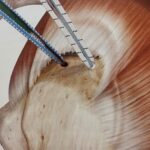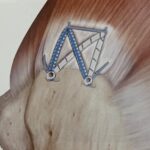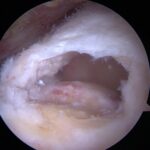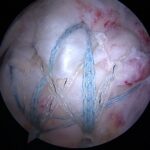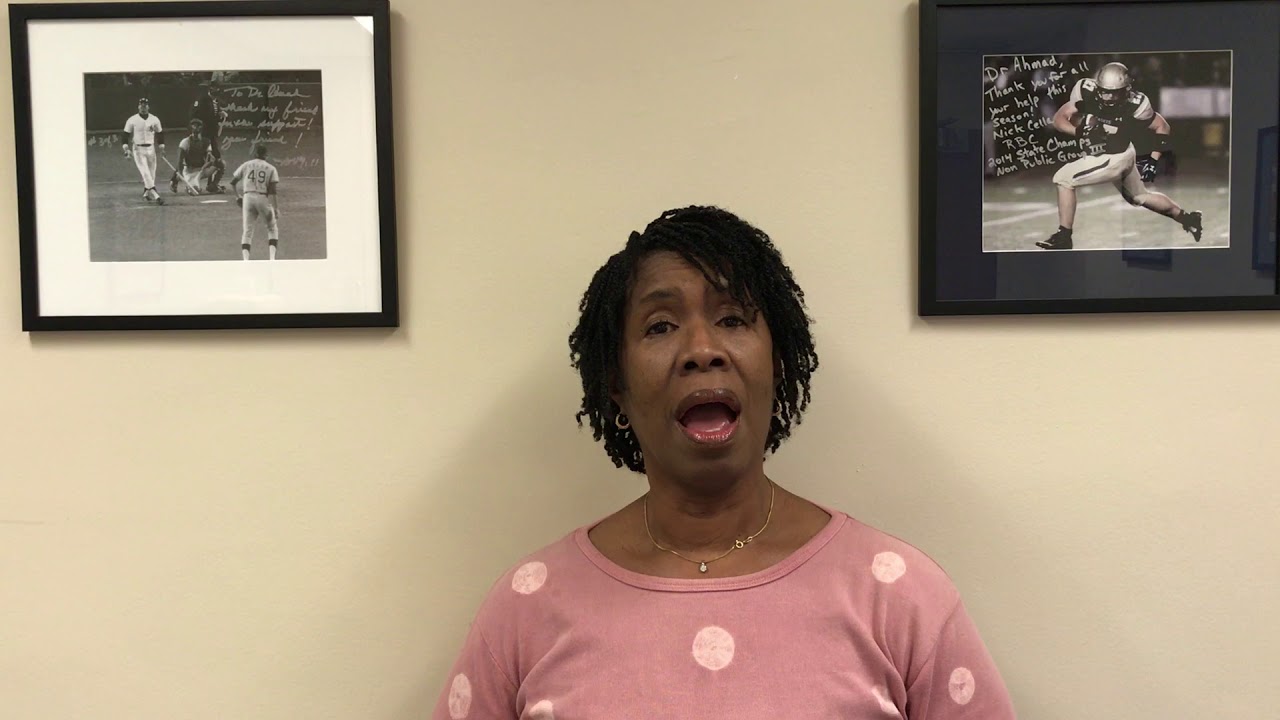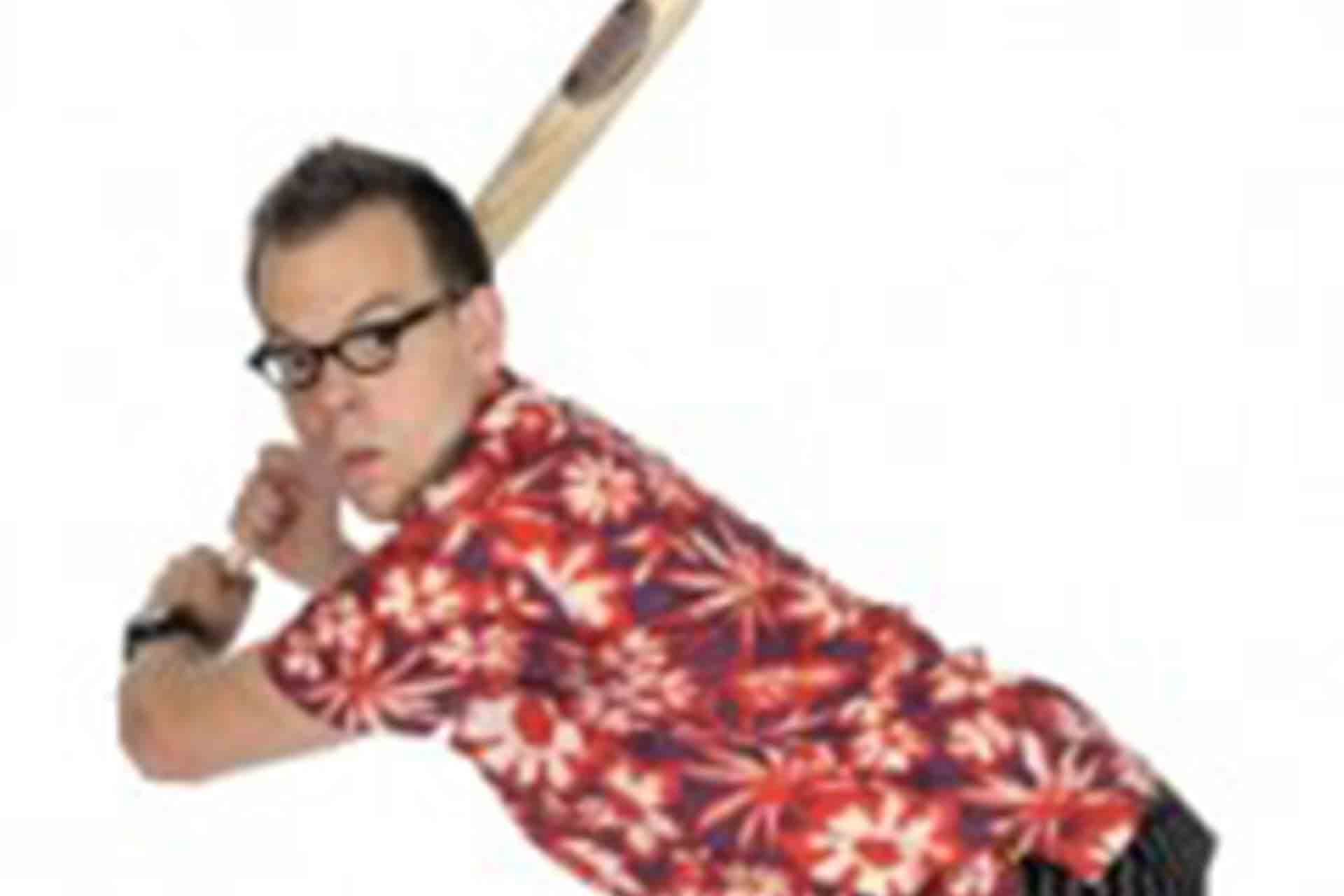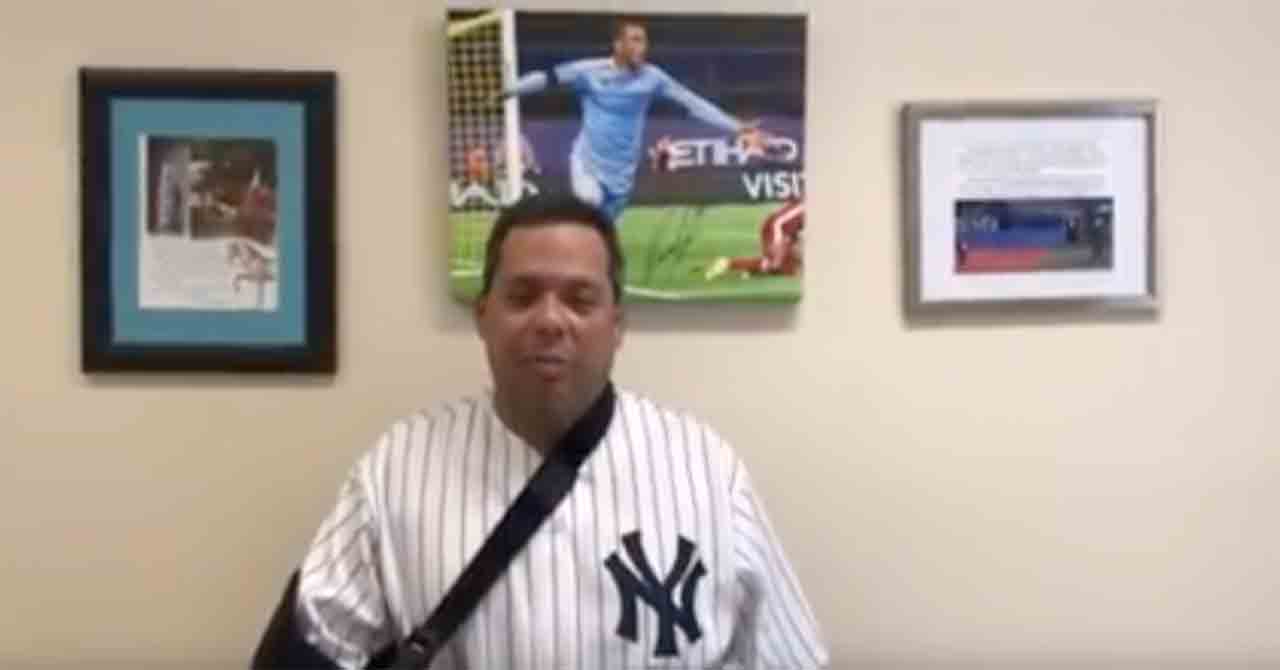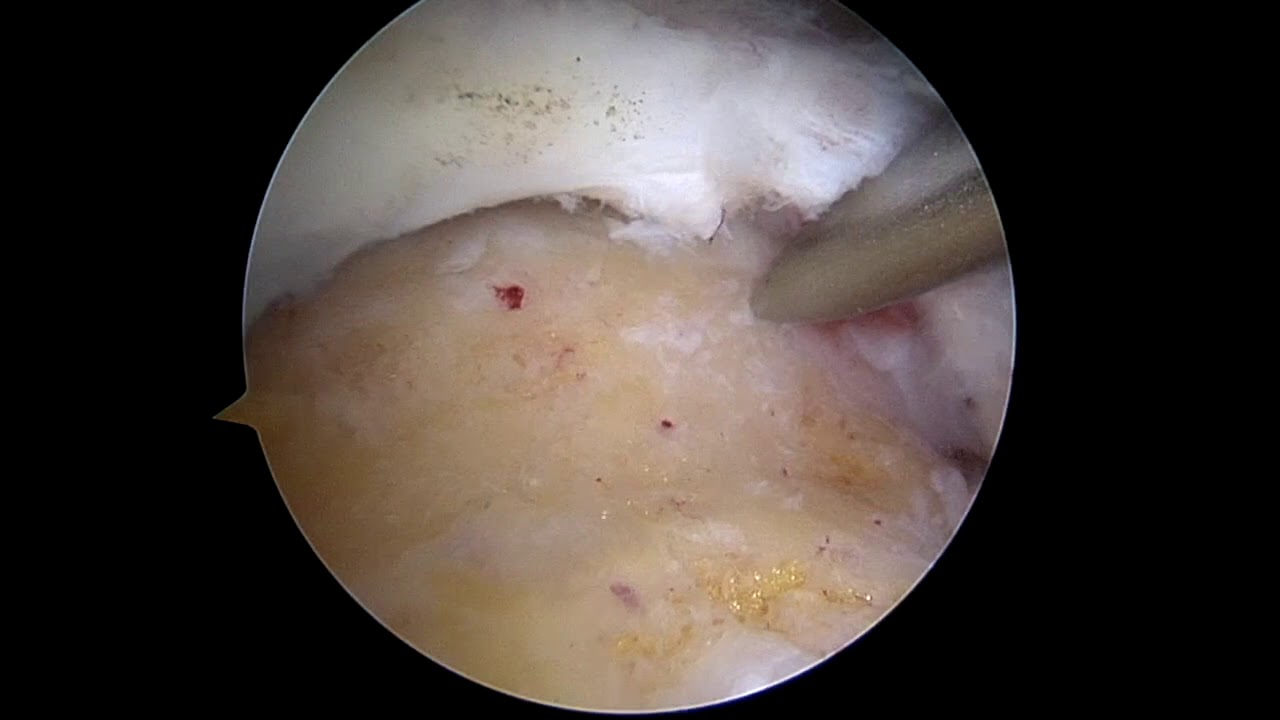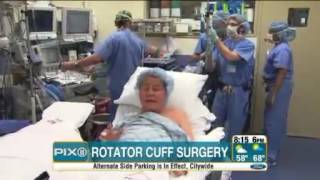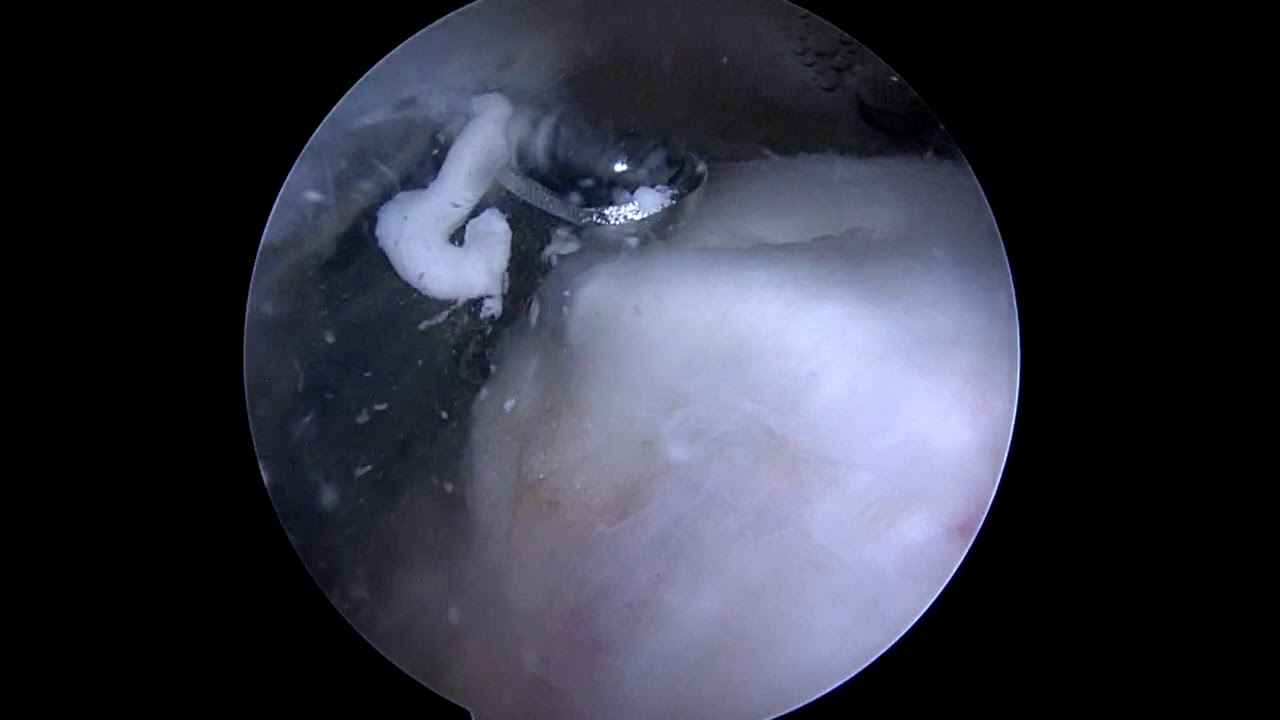Overview
Rotator Cuff Tear & Calcific Tendinitis
Most adults experience some form of persistent physical pain, and for many it is located in their shoulder.
A torn Rotator Cuff is one of the leading causes of shoulder pain and weakness, and is estimated to impact over 2 million lives in the United States.
Calcific Tendinitis is a condition that can cause intense shoulder pain that usually comes on suddenly. The pain severity can be so intense that some patients go to the emergency room for treatment when the pain starts.
- Your Rotator Cuff is: A group of muscles and tendons that connect the humerus (upper arm bone) to your shoulder’s ball and socket joint. The rotator cuff enables you to rotate and lift your arm, and also helps stabilize your shoulder joint.
- Calcific Tendinitis is: A result of calcium building up in the shoulder’s tendons. Pain and stiffness can occur, and last for months.
The Facts on Rotator Cuff Tears:
 Initial phase of injury is typically the result of the Bursa —a lining of tissue over the rotator cuff —rubbing against the acromion bone above it.
Initial phase of injury is typically the result of the Bursa —a lining of tissue over the rotator cuff —rubbing against the acromion bone above it.- A small, or partial tendon tear can progress to a large or even complete tear.
- The source of a tear can be acute, meaning immediately from an injury such as falling, or it can come from degenerative wear overtime due to overuse.
- Many patients experience:
- Pain during rest at night—particularly if lying down
- Pain when lifting and lowering your arm
- Weakness when lifting or rotating your arm
The Facts on Calcific Tendinitis:
The calcium that causes this condition, usually builds up inside of the rotator cuff. The shoulder pain makes it difficult to rest or lie down. Calcific Tendinitis mostly impacts adults between the ages of 30 and 50 years of age.
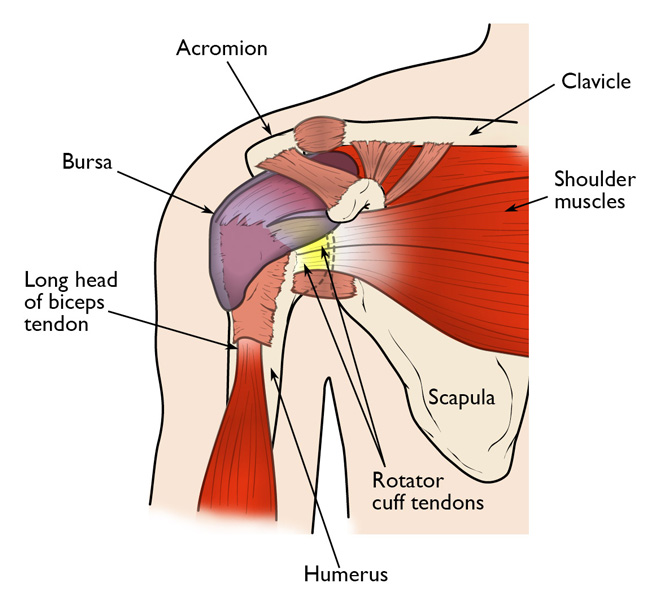
Symptoms of a Torn Rotator Cuff
Shoulder pain from rotator cuff injury is usually a result of inflammation, but it can also be from small to large tendon tear.
An Inflamed Rotator Cuff: Is typically the result of the Bursa—a lining of tissue between the rotator cuff that counters friction in the shoulder joint—rubbing against the acromion bone which sits above the rotator cuff.
Tendinitis and Bursitis are common results of the friction, and both share the symptom of intense and painful inflammation. The symptoms can be worse if your shoulder has spurs, or sharp edges on the acromion bone.
A Torn Rotator Cuff: The result of ongoing irritation and inflammation of your rotator cuff tendons, causing them to become weak and vulnerable to tearing, both during physically activity, and slowly over time.
Untreated, damage will progress toward a complete tendon tear.
Types of Rotator Cuff Tears
- Partial tear: The tendon tears, but does not fully detach from the bone.
- Complete tear: The tendon fully detaches from the bone.
- Acute Tear: Sudden force to your shoulder, such as falling down or lifting something too heavy, can cause the rotator cuff to tear immediately.
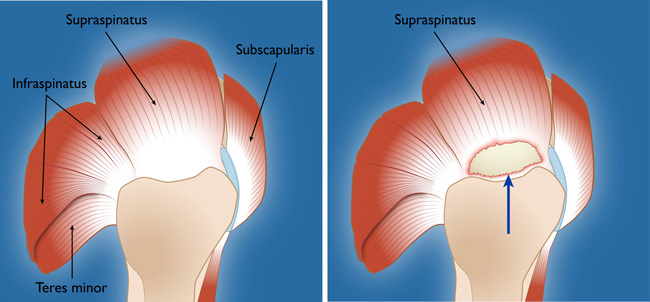
(Left) A side view of the four tendons that form the rotator cuff.
(Right) A common full-thickness tear of the supraspinatus tendon portion of the rotator cuff.
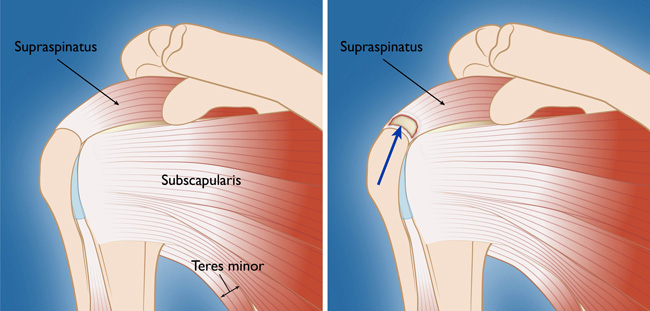
(Left) Front view of rotator cuff a normal rotator cuff
(Right) A full-thickness tear in the supraspinatus tendon.
Degenerative Tear
Tendon degeneration is the weakening of the tendons in your shoulder over time, resulting in small tears that grow larger if untreated. A degenerative tear in one of your shoulders increases your chances of a tear in your opposite shoulder.
Causes of Degenerative Rotator Cuff Tears
- Repetitive activity: Activities such as baseball, tennis, rowing, and weightlifting repeat the same shoulder motions and can put you at risk.
- Lack of blood supply: With age, the blood supply in our rotator cuff tendons decreases, and our ability to naturally repair tendon damage is impaired.
- Bone spurs: These bony projections frequently develop on the underside of the acromion bone. When we lift our arms, the spurs rub against the rotator cuff tendon. This condition is called shoulder impingement, and over time weakens the tendon and makes it more likely to tear.
Symptoms of Calcific Tendinitis
The most commonly reported symptoms are:
- Localized shoulder pain
- Limited shoulder motion and strength
Evaluation by Team Ahmad
Dr. Ahmad and his team of health professionals will greet you and start your visit with a discussion of your symptoms and your sport, level of competition, or desired activity level. Next, the doctor will exam your knee, focusing on:
- Assessing your symptoms
- Examining areas of tenderness
- Assessing your shoulder motion
- Gauging your shoulder strength and health
Depending on what is seen, Dr. Ahmad may order tests such as:
- X-rays to check for bone spurs
- MRI scans to check for tendon tears
These tests can often be performed the same day as your initial evaluation in effort to save you time.
Our treatment goals are simple—reduce pain, restore function, get you back in the game.
There are several treatment options for a rotator cuff tear, and the best option is different for every person.
In planning your treatment, Dr. Ahmad will consider your
- Activity level
- General health
- Type of tendon tear you have
- and most importantly—what you like to do
Treatment Options for Rotator Cuff Repair & Calcific Tendinitis
If you are experiencing intense shoulder pain, you may have a rotator cuff tear—do not continue to keep using your arm. Instead seek medical attention to determine the severity of your injury.
Non-surgical
Non-surgical treatment options may include a combination of the following treatment approaches:
- Activity modification: Avoid activities that cause shoulder pain.
- Nonsteroidal anti-inflammatory medication: Medications like ibuprofen and naproxen reduce pain and swelling.
- Strengthening exercises and Physical Therapy: Rotator cuff specific exercises can restore movement and strengthen your shoulder.
- Cortisone injection: Cortisone is an anti-inflammatory medicine that acts rapidly, effectively, and avoids side effects to other parts of your body.
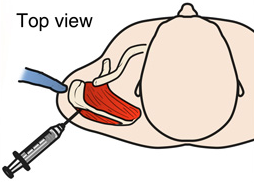
Surgical
Continued pain and compromised function is the main indication for surgery, others include:
- Your symptoms have lasted several months
- You have a large tear and the quality of the surrounding tissue is good
- You have significant weakness and loss of function in your shoulder
- Your tear was caused by a recent, acute injury
Surgery to repair a torn rotator cuff most often involves re-attaching the tendon to its normal bone attachment site.
The treatment of calcific tendinitis is similar to that of rotator cuff injuries.
Treatment includes:
- anti-inflammatory medication
- physical therapy
- a cortisone injection, depending on need
Some patients fail to respond to the non-operative treatment and symptoms continue. For these patients Dr. Ahmad recommends arthroscopic removal of the calcium, and possible repair of the rotator cuff.
Surgery for removal of the calcium has a high success rate and patients have great satisfaction with their pain relief restored motion function and ability to get back to the things they like doing.
Dr. Ahmad’s Experience
Dr. Ahmad is nationally recognized expert in rotator cuff surgery has designed and studied the optimal methods to surgical repair tears of the rotator cuff. His undergraduate training in mechanical engineering has allowed him to research the strength of the rotator cuff repair and methods that accelerate healing. Dr. Ahmad has performed nearly 1000 rotator cuff repairs in all types of patients from professional pitchers, orthopedic surgeons themselves, to those who enjoy relaxing gardening.
Listed below is Dr. Ahmad’s scholarly articles and research published to help advance rotator cuff medicine.
Review Articles, Current Concept Articles and Surgical Techniques
- Noticewala, MS, Ahmad CS: Double-row Rotator Cuff Repair: The New Gold Standard, Techniques in Shoulder & Elbow Surgery, 16:6-9, 2015
- Bell JE, Ahmad CS: Current Concepts in Arthroscopic Rotator Cuff Repair: Single vs. Double Row Repair. Current Opinion in Orthopedics, 18:363-368, 2007
- Ahmad CS, ElAttrache NS: Update on Repair Biomechanics for Rotator Cuff Fixation. Techniques in Shoulder and Elbow Surgery, 8:58-68, 2007
- Ahmad CS, Bigliani LU, Levine WN: Arthroscopic Rotator Cuff Repair. Orthopedics, 27:570-574, 2004
Peer Reviewed Scientific Journal Articles
- Anakwenze OA, Kwon D, O’Donnell E, Levine WN, Ahmad CS: Surgical Treatment of Posterolateral Rotatory Instability of the Elbow, 30(7):866-871, 2014
- Redler LH, Byram IR, Tsui YL, Moen TC, Gardner TR, Ahmad CS: Influence of Rotator Cuff Tear Size and Repair Technique on the Creation and Management of Dog Ear Deformities in a Transosseous-Equivalent Rotator Cuff Repair Model, Orthopaedic Journal of Sports Medicine, vol. 2, 4: 2325967114529257, 2014
- Kim HM, Caldwell JM, Buza JA, Fink LA, Ahmad CS, Bigliani LU, Levine WN. Factors affecting satisfaction and shoulder function in patients with a recurrent rotator cuff tear. J Bone Joint Surg Am, 15;96(2):106-12, 2014
- Levy DM, Saifi C, Perri JL, Zhang R, Gardner TR, Ahmad CS: Rotator cuff repair augmentation with local autogenous bone marrow via humeral cannulation in a rat model. J Shoulder Elbow Surg, 22(9):1256-64, 2013
- Coe M, Greiwe RM, Joshi R, Snyder BM, Tosteson AN, Ahmad CS, Levine WN, Bell JE, Simpson L: The Cost Effectiveness of Reverse Total Shoulder Arthroplasty Compared to Hemiarthroplasty for Rotator Cuff Arthropathy, Journal of Shoulder and Elbow Surgery, 21(10):1278-88, 2012
- Levy DM, Moen TC, Ahmad CS: Bone Grafting of Humeral Head Cystic Defects during Rotator Cuff Repair, American Journal of Orthopaedics, 41(2): 92-94, 2012
- Pedowitz RA, Yamaguchi K, Ahmad CS, Burks RT, Flatow EL, Green A, Wies JL, St Andre J, Boyer K, Iannotti JP, Miller BS, Tashjian R, Watters WC, Weber K, Turkelson CM, Raymond L, Sluka P, McGowan R: Academy of Orthopaedic Surgeons Clinical Practice Guideline on: optimizing the management of rotator cuff problems, Journal of Bone Joint Surg Am, 18; 94(2):163-7, 2012
- Cadet ER, Vorys GC, Rahman R, Park SH, Gardner TR, Lee FY, Levine WN, Bigliani LU, Ahmad CS: Improving Bone Density at the Rotator Cuff Footprint Increases Supraspinatus Tendon Failure Stress in a Rat Model. Journal of Orthopaedic Research, 28: 308-314, 2009
- Ahmad CS, Vorys GC, Covey A, Levine WN, Gardner TR, Bigliani LU: Rotator Cuff Repair Fluid Extravasation Characteristics are Influenced by Repair Technique. Journal of Shoulder and Elbow Surgery, 18:976-981, 2009
- Cadet ER, Hsu JW, Levine WN, Bigliani LU, Ahmad CS: The Relationship between Greater Tuberosity Osteopenia and the Chronicity of Rotator Cuff Tears. Journal of Shoulder and Elbow Surgery, 17:73-7, 2008
- Kowolsky MS, Dellenbaugh SG, Erlichman DB, Gardner TR, Levine, WN, Ahmad CS: Evaluation of Suture Abrasion Against Rotator Cuff Tendon and Proximal Humerus Bone. Arthroscopy, 24:329-334, 2008
- Ahmad CS, Kleweno C, Jacir A, Bell JE, Gardner TR, Levine WN, Bigliani LU: Biomechanical Performance of Rotator Cuff Repairs with Humeral Rotation: A New Rotator Cuff Repair Failure Model. American Journal of Sports Medicine, 36:888-92, 2008
- Park MC, Jun BJ, Park CJ, Ahmad CS, Elattrache NS, Lee TQ: The Biomechanical Effects of Dynamic External Rotation on Rotator Cuff Repair Compared to Testing With the Humerus Fixed. American Journal of Sports Medicine, 35:1931-9, 2007
- Park MC, ElAttrache, NS, Tibone JE, Ahmad CS, Jun BJ, Lee TQ: Part II: Biomechanical Assessment for a Footprint-Restoring “Transosseous-Equivalent” Rotator Cuff Repair Technique Compared to a Double-Row Repair Technique. Journal of Shoulder and Elbow Surgery, 16:469-76, 2007
- Park MC, ElAttrache, NS, Tibone JE, Ahmad CS, Jun BJ, Lee TQ: Part I: Footprint Contact Characteristics for a “Transosseous-Equivalent” Rotator Cuff Repair Technique Compared to a Double-Row Technique. Journal of Shoulder and Elbow Surgery, 16:461-8, 2007
- Ahmad CS, Wing D, Gardner TR, Levine WN, Bigliani LU: Biomechanical Evaluation of Subscapularis Repairs Used During Total Shoulder Replacement. Journal of Shoulder and Elbow Surgery, 16:s59-64, 2006
- Park M, Ahmad CS ElAttrache NS, Tibone JE: Trans-osseous Equivalent Rotator Cuff Repair Technique. Arthroscopy, 22:1360e1-e5, 2006
- Park M, Cadet E, Levine, WN, Bigliani LU, Ahmad CS: Comparison of Rotator Cuff Tendon Pressure Against the Tuberosity in Suture Anchor and Transosseous Suture Rotator Cuff Repairs. American Journal of Sports Medicine, 33:1154-9, 2005
- Ahmad CS, Stewart AM, Izquierdo R, Bigliani LU: Comparison of Tendon Bone Interface Motion for Suture Anchor and Transosseous Suture Rotator Cuff Repairs. American Journal of Sports Medicine, 33: 1667-1671, 2005
Commentaries, Perspectives, NewslettersSection
- Partial Rotator Cuff Tear-Counter point-In-situ, AANA Newsletter, Fall 2011
- Ahmad CS: Is Impingement Syndrome an Accurate Diagnosis and What if the Role for Acromioplasty?, Journal of Bone and Joint Surgery, 2011
- Ahmad CS: Identifying the Tear Pattern is the Key to Repairing Massive Rotator Cuff Tears, Orthopaedics Today Ortho Supersite, 2009
- ElAttrache NS, Ahmad CS, Burkhart SS, Mazzocca AD, Snyder SJ Dines JS: Rotator Cuff Repair: Current Concepts and Applications. Orthopedics Today, 28:46, 2008
- Ahmad CS: Partial Thickness Rotator Cuff Tears. Orthopaedics Today, 27:30, 2007
- Ahmad CS: Double Row Rotator Cuff Repair Techniques. Orthopaedics Today, 26:212-122, 2006
Textbooks/ Guest Editorship
- Ahmad CS, Levine WN, Cadet EC, Editors: Shoulder and Elbow Trauma, JP Medical Ltd, London, 2012
- Ahmad CS, Editor: Sports Medicine 2. Instructional Course Lectures Sports Medicine Specialty Volume 2: American Academy of Orthopaedic Surgeons, Illinois, 2011
- Levine WN, Ahmad CS, Co-Editors: Current Concepts in Elbow Surgery Part-2 Trauma/Reconstruction. Operative Techniques in Orthopaedics. Elsevier, Illinois. Vol 20, pp 1-68, 2010
- Levine WN, Blaine TA, and Ahmad CS, Editors: Minimally Invasive Shoulder and Elbow Surgery. Informa Publishers, New York. 2007
Book Chapters
- ElAttrache N, Hodgins J, Gonzales-Lomas G, Ahmad CS, “The Shoulder in Athletes”, Rockwood and Matsen’s The Shoulder, Elsevier Saunders,Philadelphia, August 2016.
- Ahmad CS, ElAttrache: Partial Thickness Rotator Cuff Tears in Throwing Athletes: Sports Medicine of Baseball: Dines,
ElAttrache, Yocum, Altchek, Andrews, Wilk, Editors: Lippincott Williams & Wilkins, Maryland, 2012 - Lomas G, Ahmad CS, ElAttrache NS: The Shoulder in Athletes, The Shoulder 4th Edition: Rockwood,
Matsen, Wirth, Lippitt, Editors: Elsevier, Illinois, 2009 - Ahmad CS : Elbow Injuries in the Athlete,American Academy of Orthopaedic Surgeons. Comprehensive Orthopaedic
Review: Lieberman, Editor: American Academy of Orthopaedic Surgeons, Illinois, 2009 - Ahmad CS, ElAttrache NS: Double Row Rotator Cuff Repair,Surgical Techniques of the Shoulder, Elbow, and Knee in Sports Medicine: Cole BJ, Sekiya JK, Editors: Elsevier, Philadelphia, 2008
National Research Podium Presentations Presented
- Lomas GG, Kippe MA, Brown GD, Ding, A, Gardner TR, Levine WN, Ahmad, CS:In-Situ Transtendon Repair Outperforms Tear Completion and Repair for Partial Articular-sided Supraspinatus Tendon Avulsions. 6thBiennial American Academy of Orthopaedic Surgeons/American Shoulder Elbow Surgeons Meeting, Orlando FL, April 2008
- Ahmad CS, Kleweno C, Jacir A, Bell JE, Gardner TR, Levine WN, Bigliani LU: Biomechanical Performance of Rotator Cuff Repairs with Humeral Rotation: A New Rotator Cuff Repair Failure Model.American Orthopaedic Society for Sports Medicine Annual Meeting,Hershey PA, July 2006
- Park, M, Tibone JE, ElAttrache NS,Ahmad CS, Bong JJ Lee TQ: Biomechanical Assessment for a Footprint-Restoring “Transosseous-Equivalent” Rotator Cuff Repair Technique Compared to a
Double-Row Technique.5th Biennial AAOS/ASES Shoulder and Elbow Meeting, Orlando FL, April 2006 - Park M, Cadet E, Levine, WN, Bigliani LU,Ahmad CS: Comparison of Rotator Cuff Tendon Pressure Against the Tuberosity for Suture Anchor and Transosseous Suture Rotator Cuff Repairs.Arthroscopy Association of North America Annual Meeting,Vancouver, BC, May 2005
- Stewart A, Izquierdo R, Bigliani LU,Ahmad CS: Comparison of Tendon Bone Interface Motion for Suture Anchor and Transosseous Suture Rotator Cuff Repairs.American Orthopaedic Society for Sports Medicine Annual Meeting,Quebec Canada, June 2004
- Park, M, Tibone JE, ElAttrache NS,Ahmad CS, Bong JJ Lee TQ: Biomechanical Assessment for a Footprint-Restoring “Transosseous-Equivalent” Rotator Cuff Repair Technique Compared to a
Double-Row Technique.American Orthopaedic Society for Sports Medicine Annual Meeting,Hershey PA, July 2006 - Park M, Cadet E, Levine, WN, Bigliani LU,Ahmad CS: Comparison of Rotator Cuff Tendon Pressure Against the Tuberosity for Suture Anchor and Transosseous Suture Rotator Cuff Repairs.American Orthopaedic Society for Sports Medicine Specialty Day,Washington DC, February 2005
- Stewart AM, Izquierdo R, Bigliani LU,Ahmad CS: Comparison of Tendon Bone Interface Motion for Suture Anchor and Transosseous Suture Rotator Cuff Repairs.OREF New York Resident Research Competition & Symposium, New York NY, May 2003
- Sugalski MT,Ahmad CS, Wiater JM, Levine WN, Bigliani LU: The Confluence of the Subscapularis Insertion and the Glenohumeral Joint Capsule.OREF New York Resident Research Competition & Symposium, New York NY, May 2003
- AAOS ICL 249,Ahmad CS,Parsons B, Verborgt O, Galatz L: Arthroscopic Rotator Cuff Repair: An Evolution of Techniques. Are Our Patients Really Benefiting?-Techniques and Implants – Devices, Technique, and Instrumentation and their Effect on Cuff Healing?.American Academy of Orthopaedic Surgeons,New Orleans, LA, March 2014
- AAOS ICL 348,Ahmad CS,Parsons B, Verborgt O, Galatz L: Arthroscopic Rotator Cuff Repair: An Evolution of Techniques. Are Our Patients Really Benefiting?-Techniques and Implants – Devices, Technique, and Instrumentation and their Effect on Cuff Healing?.American Academy of Orthopaedic Surgeons,Chicago, IL, March 2013
- AAOS ICLAhmad CS,Parsons B, Verborgt O, Galatz L: Arthroscopic Rotator Cuff Repair: An Evolution of Techniques. Are Our Patients Really Benefiting?-Techniques and Implants – Devices, Technique, and Instrumentation and their Effect on Cuff Healing?.American Academy of Orthopaedic Surgeons,San Francisco, CA, February 2012
- AAOS ICL 127-The Unstable Elbow: Current Concepts in Diagnosis and Treatment. Elbow MCL
- Ahmad CS:IC202 –Rotator Cuff Repair Controversies; Double Row Rotator Cuff Repair – Is it Cost Effective.American Orthopaedic Society for Sports Medicine Annual Meeting,Seattle WA, July 2014
- AOSSM Annual Meeting, Faculty, Forgive the Interruption, Double Row Rotator Cuff Repair. Orlando FL, July 2008
- AOSSM Annual MeetingICL, Faculty, Rotator cuff: Partial Thickness Rotator Cuff Repairs. Orlando FL. July 2008
- AOSSM ICL, Faculty, Rotator Cuff: Partial Thickness Rotator Cuff Repairs. Hershey PA, June 2007
- AOSSM ICL, Faculty, Rotator Cuff: Partial Thickness Rotator Cuff Repairs. Hershey PA, June 2006
- ASES/AAOS Open Meeting Symposium, Faculty, Double Row Rotator Cuff Repair. San Francisco CA, March 2008
- Orthopedics Today Symposium, Faculty, Subscap Management Pearls for Primary and Revision TSR, Lahaina, HI, January 2017
- Orthopedics Today Symposium, Faculty, Double Row Rotator: Evidence Made Simple, Lahaina, HI, January 2017
- Orthopedics Today Symposium, Faculty, Massive Rotator Cuff Tear Repair Techniques, Lahaina, HI, January 2017
- Orthopedics Today Symposium, Faculty, Panel Discussion, Rotator Cuff and Pectoralis Major, Case Presentations, Audience Questions and Discussion, Lahaina, HI, January 2017
- Orthopedics Today Symposium, Faculty, Partial Thickness Rotator Cuff Tears: Take Down vs. In Situ Repair, Waikoloa, HI, January 2016
- Orthopedics Today Symposium,Faculty, Double Row Rotator Cuff Repair: Why or Why Not, Koala, HI, January 2015
- Orthopedics Today Symposium,Faculty, Partial Thickness Rotator Cuff Tears: How do I decide, Maui, Hawaii, January 2014
- Orthopedics Today Symposium,Faculty, Surgicenter Approach – Is the Increased Cost of a Double Row Repair Worth it?, Kona Hawaii, January 2013
- Orthopedics Today Symposium,Faculty, (Rotator Cuff) Partial Thickness Rotator Cuff Tears: Debride, In Situ Repair, or Convert to Full Thickness Repair. Kihei Hawaii, January 2012
- Orthopedics Today Symposium,Faculty, Partial Thickness Cuff Tears: When Should I Debride, Repair or convert To Full Thickness Repair?, Kauai, Hawaii, January 2011
- Orthopedics Today Symposium,Moderator, Shoulder Part 1 Rotator Cuff, Kauai, Hawaii, January 2011
- Orthopedics Today Symposium,Faculty, Cuff Tear Recognition-Is it L or a U?. Maui Hawaii, January 2010
- Orthopaedics Today Symposium, Faculty, Shoulder Update 2009, Massive Cuff Tears: Techniques to Fix. Kohala Coast Hawaii, January 2009
- Orthopedics Today Symposium,Faculty, Arthroscopic Double Row Suture Bridge RCR: Rational. Maui Hawaii, January 2008
- Center for Shoulder, Elbow and Sports Medicine – Current Concepts in Shoulder Surgery,Looking Towards the Future: 2013 Update on Current Surgical Techniques in Rotator Cuff Repair, New York, April 20, 2013
- International Symposium on Shoulder and Elbow Arthroscopy, Faculty, Mechanics of Repair: What is the Best Construct? New York, NY October 2009
- Boston Sports Medicine Symposium, Faculty, Rotator Cuff-Biomechanical Rationale for Footprint Reconstruction Techniques. Boston MA, June 2009
- Evaluation & Treatment of the Injured Athlete, Faculty, Sports Medicine Update, Irreparable Rotator Cuff Tears, June 2007
- New York Hospital Orthopaedic Hospital Alumni Association biennial Meeting,Faculty, Optimizing Arthroscopic Rotator Cuff Repair. New York NY, April 2007
- Northeast Sports Medicine Conference,Transosseous Equivalent Rotator Cuff Repair: Pearls and Pitfalls. West Point NY, May 2006
- NYOH Biennial Meeting,Faculty, Rotator Cuff Repair Mechanics. New York NY, May 2005
- NYOH Biennial Meeting, Faculty, Partial Thickness Rotator Cuff Repair In Situ. New York NY, May 2005
- AANA Annual Meeting, Patellofemoral Problems Instructional Course, Faculty, Tendon-to-Bone Pressure Distributions at a Repaired Rotator Cuff Footprint Using Transosseous Suture and Suture Anchor Fixation Techniques. Vancouver Canada, May 2005
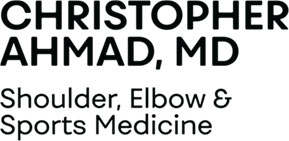

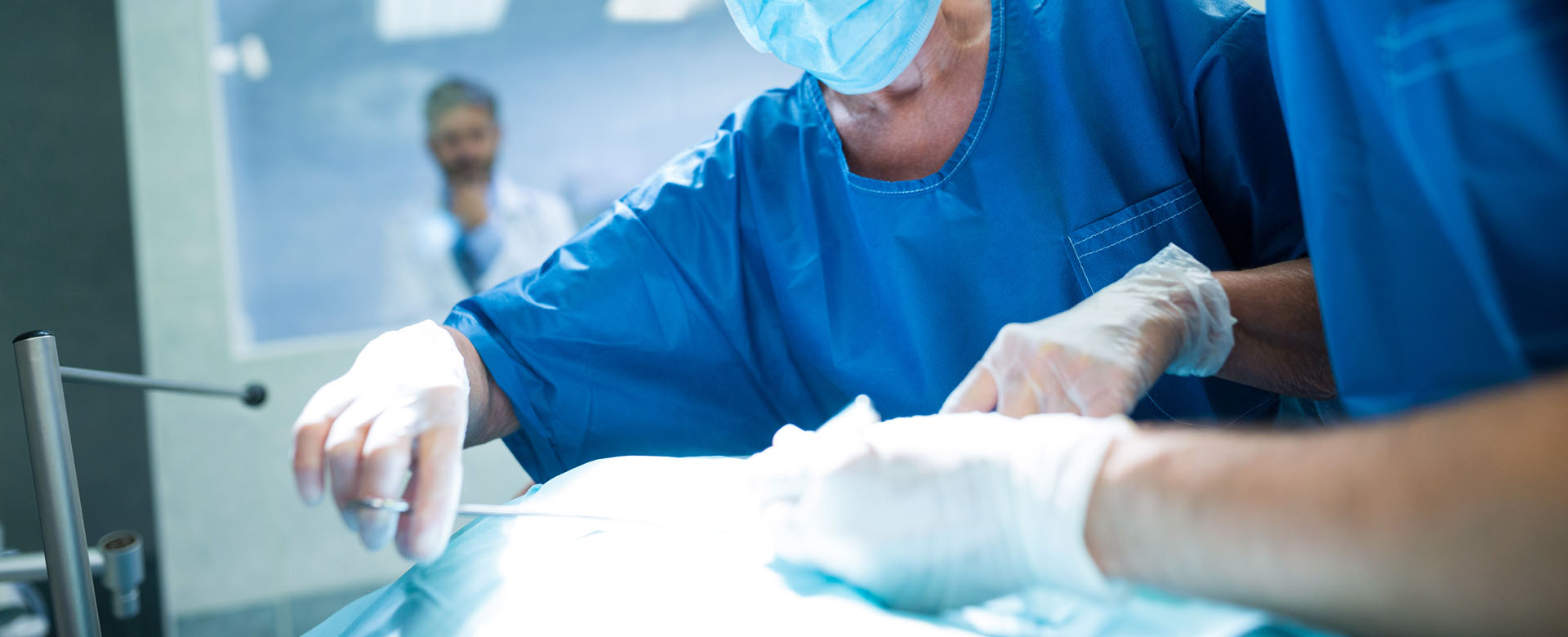
 Initial phase of injury is typically the result of the Bursa —a lining of tissue over the rotator cuff —rubbing against the acromion bone above it.
Initial phase of injury is typically the result of the Bursa —a lining of tissue over the rotator cuff —rubbing against the acromion bone above it.